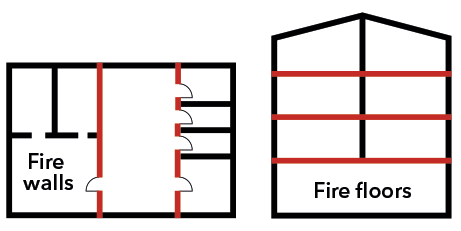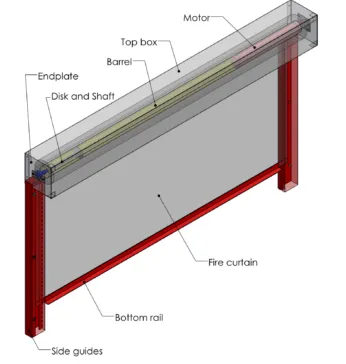Join over 1,000 UK businesses who have already had Fire Protection installed by Ark Fire Protection.

Passive Fire Protection
Passive fire protection (PFP) is an essential component of any fire safety plan. It is an increasingly important element in safeguarding people and minimising damage to buildings from fire and smoke.
Passive fire stopping systems work by preventing the spread of fire and lowering its extremity. The phrase refers to a wide range of products and procedures, although it is usually used to describe materials incorporated into buildings that make them more resistant to fire.
The two main objectives of passive fire protection systems are to make a building safer for evacuation while also preventing a fire from developing into a threat to life.
Fire typically spreads from one item to the next, which some PFP products attempt to tackle, and then from room to room, which things like intumescent materials try and prevent. Regardless of the approach taken, PFP’s fundamental objective is to limit or stop the spread of fire.

So, what is Passive fire protection? Passive fire protection in buildings is a series of measures designed to promote the protection from fire in various structures. It aims to help slow the spread of fire or contain flames by installing fire-resistant walls, floors and doors. By cordoning off building sections, the potential damage caused by a fire is limited. It is also a useful way to give occupants more time to evacuate a building if there is a fire safely.
When trying to understand why passive fire stopping is important, it helps to know how it works. By using passive fire protection materials that can withstand high temperatures, the structural integrity of the building is greatly enhanced. Structures will take longer to collapse with passive fire protection measures installed, and other issues like fire or smoke spread are also limited.
Active and passive fire protection in buildings are both crucial elements in safeguarding structures against fire hazards, yet they operate differently. Active fire protection involves the detection, alarm, and suppression systems that require action to work, such as sprinklers, fire extinguishers, and alarm systems. These systems actively respond to fire incidents to control or extinguish them. In contrast, passive fire protection systems involve building components and design strategies aimed at containing fires and preventing spread, such as fire-resistant walls, doors, and barriers. These systems don’t require movement or an external trigger to function, as they’re built into the structure to compartmentalise and limit the damage caused by fires. Together, these systems provide a comprehensive fire safety strategy.
Active Fire Protection, or AFP, are tools and systems that provide fire protection in buildings if an action or motion is taken. For example, AFP commonly needs to be manually operated or switched on. The most common forms of AFP include:
Fire alarms are classified as active protection as they must be activated (usually by breaking glass and pressing a button) in order to work. Once activated, a fire alarm gives off a loud, ringing or high-pitched noise to inform all inhabitants in a building that there is a fire risk and that they must exit the building immediately.
Some sprinkler systems may need to be manually activated whereas others are triggered by a fire alarm, making them an active form of fire protection. Sprinkler systems release a spray of water to immediately put out or stop the spread of a fire.
As fire extinguishers need to be manually operated, they are also forms of active protection. Firefighters using fire extinguishers are also considered an active form of protection. Most fire extinguishers release a dry chemical foam or powder which can be used to smother a flame.
When comparing examples of active and passive fire protection, it’s beneficial to first understand the definition of passive protection. Passive Fire Protection, or PFP, is an umbrella term for systems and tools within a building that don’t need to be activated or manually operated. The primary objective of passive fire protection materials is to compartmentalise and stop a fire from spreading throughout a building. The most common forms of PFP include:
Fire doors are specialist doors that have been designed to withstand fires for as long as possible. For example, if a fire door is closed in a room with a fire, it will prevent the fire from spreading outside of the room before fire services arrive. The doors don’t need to be ‘activated’ as such to work, which is why they are considered passive protection.
Similarly, as fire compartmentation is related to the design of a building, it is a passive rather than active form of protection. Fire compartmentation is the division of a property into small sections or units to stop a fire from consuming an entire building. Each section or containment is complete with fire doors or cavity barriers, for example, to prevent or slow the progression of fire or smoke.
When intumescent paint is exposed to high levels of heat, such as the heat caused by a fire, it swells and chars. As the paint grows in thickness and produces a char, it becomes an insulating layer of protection and protects the structures underneath it. This can play a pivotal role in ensuring the building remains upright as it can effectively protect load bearing struts.
While it is useful to learn the difference between active and passive fire protection systems, it is important to understand that both types of protection work together in unison. Both active and passive fire systems are designed to work together, help save lives and protect a building.
Active protection systems are usually designed to put a fire out, whereas passive systems support the active measures put in place by limiting the spread of a fire. When one system faults, the other system is in place to manage the fire.
For example, if a sprinkler system fails to start due to frozen pipes or a wiring fault, a fire door will stop the fire from spreading whilst emergency services are on their way. Similarly, if a fire door isn’t shut properly, a fire extinguisher can be used to stop a fire from reaching a doorway.
Every structure, no matter how big or small, should have an emergency fire plan. The Building Regulations 2019, Fire Safety, Approved Document B – Requirement B3, Internal Fire Spread (structure) states “The building shall be designed and constructed so that, in the event of a fire, its stability will be maintained for a reasonable period”, therefore it is incredibly important to comply with these laws and regulations. Passive fire protection is a key component of any emergency fire strategy because it was created for three fundamental purposes:
PFP provision is required in every structure, whether it’s residential or non-residential. The Building Regulations 2010, Fire Safety, and Approved Document B are the regulations that must be followed when constructing new buildings, renovating old ones, or extending existing structures in England. It states that “If a fire separating element is to be effective, every joint or imperfection of fit, or opening to allow services to pass through the element, should be adequately protected by sealing or fire stopping so that the fire resistance of the element is not impaired”.
The foundation for how passive fire protection works is compartmentation. To divide the structure into sections – or compartmentalised – walls, floors, and rooms are separated using various methods (which will be explained below). This ensures safety for people who live or work in buildings by allowing them more time to evacuate before the building burns down. There are plenty of methods and products used in PFP works, which include:

Passive fire stopping is the sealing of any aperture to keep fire, smoke, and heat from passing through building compartments. Fire-resistant compartments may be used to compartmentalise a structure both vertically and horizontally, limiting the spread of fire. To limit fire propagation, structures must implement fire stopping.
The typical structures being built today have far more combustible materials or components than those that have been constructed previously. Modern building fires develop and spread at a rate of around 5 to 10 times faster than buildings did in the past, according to CTIF.org. In this modern age, it is critical to safeguard or extinguish a fire if one should break out, as this means the need for priority protection of the structure or prevention of a fire is paramount.
With new structures, building firms invest heavily in pipes, HVAC ducts, and other fixings that pass through compartment parts of the property. “Weak spots” are created in the structure when gases, smoke, and flames are not adequately controlled or protected.
Firestops are used to fill in the holes or strengthen areas where heat, gas, and open flames may pass through to other parts of the structure. They’re intended to prevent hot gases, poisonous smoke, and uncontrolled fires from spreading throughout the area and surrounding structures.
Fire doors are a popular choice for compartmentation in building construction, but the installation, maintenance and inspection of fire doors are frequently neglected. Doors with fire seals are one of the most important fire safety equipment in any structure because they provide a crucial delay and can keep a fire confined to one area. This allows building occupants time to safely exit the premises and allows sufficient time for firefighters to enter and combat the blaze.
The Regulatory Reform (Fire Safety) Order 2005 covers all aspects of fire safety in buildings. Regular inspections of fire doors are essential to maintain building fire safety, as they are defined in BS 8214 (c. 13) and BS 9999 (Annex L).
Fire Doors
The use of intumescent coatings for structural steels has been proven and successful to aid buildings in the protection from fire.
Intumescent coatings, a passive protection material often known as reactive paint, react with the heat from a fire, specifically temperatures above 120°C. The paint will intumesce (swell) 50 times its thickness and form a proactive, carbon layer that thermally insulates the steel for a specified duration when exposed to temperatures above the threshold. Depending on the covering, this can be anywhere from 30 to 120 minutes. This time allows people to be safely removed from the building and protects the building’s structural integrity before firefighters can put out the fire.
There are two main types of intumescent coatings:
External fire barriers are used to stop the spread of flames and smoke throughout a building’s roof and ceiling regions, as well as any hidden voids. Fire barrier systems are recommended for voids of up to 10.5 meters tall. Vertical fire barrier systems keep both insulation and integrity for periods of up to 120 minutes, whereas friction fire slabs only provide up to 60 minutes of protection. External fire barriers limit the spread of fire and smoke within a building, when there is no barrier, fire and smoke may rapidly travel up the structure.
The passive fire protection materials that create a fire curtain are critical to its success. A fire curtain, like a roller blind, must be composed of a flexible yet durable substance in order to roll up. The core component of a fire curtain is fire resistant fiberglass. To increase resistance to heat and strengthen the curtain, fiberglass can be woven with metals. Fire curtains are considered fire resistant rather than fireproof, this is because nothing can be completely fireproof – given enough heat for long enough, anything will melt, burn, or evaporate. A flame-resistant material is simply more resilient against thermal energy and direct exposure to flame.
The retractable/falling mechanism is among the more advanced technologies employed. This device may be concealed in ceilings or housed to better match the environment. Because of its small size and robust, exact engineering inside, the curtain should function properly if the need arises.
Fire Curtains
Typically, fire resistant walls that are used to separate existing rooms in buildings must provide a barrier to the passage of fire from one side of the room to the other. Building codes and requirements for workplaces and factories typically demand a 30-minute fire resistance rating for any partitioning product.
Fire-rated partitions must meet each of the required protective criteria, depending on the application, such as integrity, insulation, and in some cases, load-bearing capacity.
There are two types of fire rated partitions, vertical and horizontal:
Third-party product certification gives assurance that the item is suitable for its intended use, that it adheres to a defined quality system, and that it is connected with factory production through testing by a fire laboratory. The different methods of third-party product certification vary somewhat from who is offering them, but they all evaluate most or all of the following criteria:
Join over 1,000 UK businesses who have already had Fire Protection installed by Ark Fire Protection.
In the United Kingdom, passive fire protection systems must comply with Building Regulations, which ensure that people can safely exit a building that does not collapse as a result of a fire. Fire safety standards are determined by legislation, which places the duty on building owners, managers, occupants, and designers to conduct regular fire risk assessments that should include a review of the PFP.
According to experts, the construction plan should have a clear fire protection strategy that includes certified passive fire components. To protect against compromising fire protection, the number of persons who might modify the specification must be limited. If a significant number of modifications are made, it is recommended that a qualified third party revises the fire protection strategy.
The Regulatory Reform (Fire Safety) Order 2005 states that “You are responsible (for fire safety) if you are an employer, landlord, owner, occupier, or anyone else in control of the premises such as a facilities manager”. “As the responsible person you must:
If you’re looking to implement passive fire stopping measures, working with an experienced passive fire protection provider such as our team at Ark Fire Protection benefits you. Doing so will ensure that the most suitable measures are installed competently and competently. You’ll benefit from a vast wealth of industry knowledge and expertise, so you can rest assured that the right materials are used in a way that aligns with the latest regulations.
If you’re looking for a tailor-made passive fire protection solution, working with an experienced provider like Ark Fire Protection is strongly advisable. It takes years of industry experience to effectively navigate the latest building regulations while also finding the right solutions – which is precisely what we do. Working with someone with in-depth industry experience will also ensure the project is completed without issues like timeline or budget extensions. The right expertise not only enhances the safety and integrity of a building but also provides peace of mind to building owners and occupants, knowing that the structure is equipped to protect them in the event of a fire.
People must be able to safely evacuate a building. People are more likely to require extra time to flee than is usually assumed due to external circumstances and confusion. The escape route must be able to resist fire for lengthy periods, regardless of what is going on in the rest of the structure.
It is simpler for the first-response teams to combat a fire if it happens in only one portion of a structure. People are also more likely to be able to evacuate safely as a result of this. The fire may be prevented from spreading throughout the facility by ensuring that walls, ceilings, and floors can withstand it.
During a fire, toxic smoke inhalation kills more people than the fire itself. It hampers visibility, creating panic and potential asphyxiation. Smoke also aids in the spread of a fire. Because of these factors, having an effective duct system for removing smoke is an important element of any passive fire protection strategy.
A structure of a building can collapse when subjected to fire. However, if the load-bearing structure of the building is protected, it will be more resilient to high temperatures. Fitting a building with structural protection may help to preserve it after a fire. An effective structural protection system will also make the facility more likely to be restored rather than destroyed after a fire.
It’s difficult to ensure the safety of people who may be trapped inside burning structures. It necessitates the proper mix of goods, procedures, and systems. Getting it right depends on the specific building, as each unique structure has its distinct demands depending on size, form, function, and materials used in construction. However, if you take both active and passive precautions, you’ll have a better chance of getting everyone safely out of a burning building.